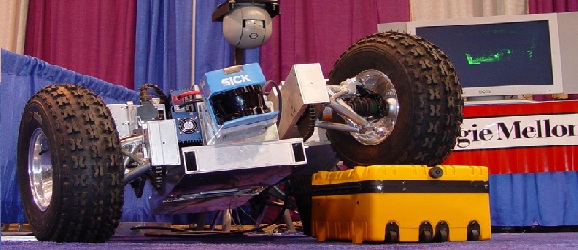Robots May Explore Volcanic Lunar Caves In The Future
This article is more than 2 years old

Remember in the ’90s when remote-controlled cars were just cars, clunky though they may have been? Then a lot of companies retooled their designs and made them adaptable to the environment, whether that meant designing the vehicle to look like a three-dimensional triangle, or adding a flipper arm on the roof to boot the car back into an upright position. There is something highly unsatisfying to me about playing with a car that looks nothing like an actual car. It must be an aesthetic thing. But when you’re building a robot rover meant to explore underground moon caverns that humans haven’t laid eyes on yet, a goal of maximum utility should be present from inception.
Despite its dated design that will probably be updated in future months, the Cave Crawler, described in this month’s Nature, has lofty and noble roots. Its creator, William “Red” Whittaker, is a roboticist at Carnegie Melon University in Pittsburgh, and has already created similar robots that have braved the depths of an Alaskan volcano, and assisted in cleaning up the Three Mile Island nuclear plant. He knows a little something about putting robots in precarious situations. Whittaker shared his plans at a meeting of the NASA Innovative Advanced Concepts (NIAC) program in Hampton, Virginia.
He hopes that by 2015, his prototype will have become that machine that’s actually passing beneath the Moon’s surface. In 2009, images of caverns were sent back from the satellite SELENE. Too deep to be just craters, these tunnels would be the first chance humans get to peek beneath the surface. Ancient alien burial grounds? Probably not. Its existence is presumed to have been caused by a volcanic eruption, with its tunnels carved by long-gone lava.
The NIAC will take about $500,000 over the next couple of years to develop Whittaker’s ideas, with an eventual turn toward SpaceX, already contracted with Whittaker’s Astrobotic Technology company, to launch the device to the moon. Beyond exploratory factors, the mission is competing for the $20 million Google Lunar X prize for being the first privately funded team to land an autonomous vehicle on the moon’s surface. Whittaker has also previously adapted a Chevrolet Tahoe to autonomously navigate California streets, using technology utilized in the Cave Crawler.
If we’re lucky, the sub-surface of the Moon could become the optimal place for future lunar base shelters. Lasers attached to the Crawler will scan the caves’ insides and digitally send the information back, allowing mapping to occur. Should this area actually be as untouched as some think, materials like rocks and dust may answer scientists’ questions about how the surface looked long ago, among other smaller mysteries.
Prometheus tech is probably still far off, due to the moon’s lack of an atmosphere, but as long as our scientists make better decisions than that film’s characters did, I’m fine with less-advanced means of exploration.












